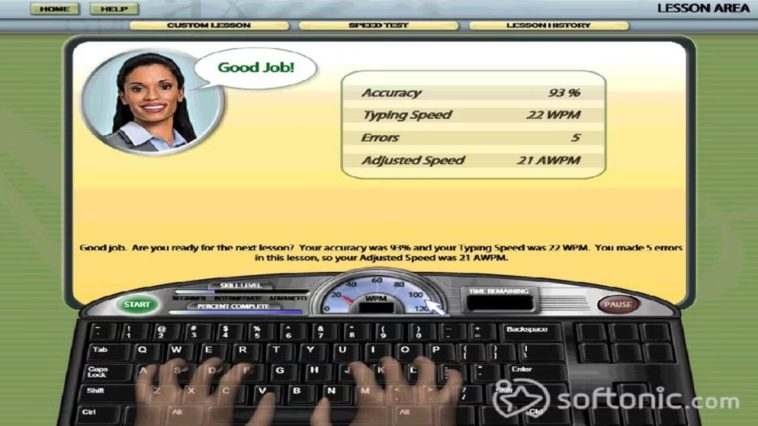Los teclados tienen más de 100 teclas, pero hay cuatro que son las más importantes para las personas que juegan videojuegos: W, A, S y D. Hay juegos que usan más que estas teclas, sí (StarCraft, League of Legends y World of Warcraft usan todo tipo de combinaciones), pero la mayoría de los juegos dependen de una pequeña muestra de números y letras en el teclado. Sin duda, hay razones prácticas para esto: los juegos de computadora a menudo requieren una mano en el mouse y la otra en el teclado. Hay un montón de claves que simplemente están fuera de nuestro alcance. Si tienes las dos manos sobre el teclado, probablemente no estés jugando a un videojuego. pero tu podría ser.
Los juegos de mecanografía han existido durante décadas y alguna vez se consideraron en gran medida herramientas educativas diseñadas para ayudar a los niños a aprender a usar un teclado. Los millennials jugaban juegos como Typer Shark y Mavis Beacon Teaches Typing en las aulas de sus laboratorios de computación, antes de que las computadoras fueran algo común en las oficinas en el hogar. A medida que las computadoras, es decir las laptops, comenzaron a proliferar, los laboratorios de computación comenzaron a desaparecer, y también lo hizo la necesidad de juegos educativos de mecanografía. Pero de las cenizas del laboratorio de computación, los juegos de mecanografía han resurgido, surgiendo de la caja de herramientas de los géneros educativos y al mismo tiempo dando un nuevo giro al género de nicho.
Mavis Beacon Teaches Typing, lanzado en 1987 y desarrollado por Software Toolworks, es el Juego de mecanografía por excelencia. No fue el primer juego de mecanografía, pero sí uno de los primeros. Mavis Beacon enseña a escribir es sin duda la más destacada; La propia Mavis es la cara del género mecanográfico, incluso hoy en día.
«Creo que el alto concepto, la idea de que el mejor profesor de mecanografía del mundo estuviera a tu lado, corrigiendo errores y ofreciéndote aliento, fue una gran parte del atractivo. [of Mavis Beacon Teaches Typing,» developer on the game Michael Duffy told GameSpot. «The ‘game’ sensibilities that we successfully employed in Chessmaster–graphics and music–made the rote repetition required to learn a new motor skill fun. The typing hands showing finger placement were highly innovative in a time of primitive graphics, and kept people from looking at their hands while typing. But the illusion of Mavis herself was a big draw.»
Mavis Beacon Teaches Typing had several games that made it more than just a typing program: Road Race, Space Junk, and Ragtime. Each of these were largely the same–typing a prompt that scrolled across the screens–but applied different effects. Tying fast made the text scroll faster in Road Race; accurate typing helped shoot more stuff in Space Junk; and Ragtime required the player to type in rhythm with a metronome. The small tweaks to how typing impacted the states of these games is what makes them satisfying, and those same practices in making typing feel responsive and tactile in games continues to drive what makes a typing game good.
Z-Type is a classic type-to-shoot game originally developed in just one week by Dominic Szablewski. He said his game is appealing because of the immediate feedback. Z-Type is an arcade-style space game in which players must shoot enemy spaceships. If they hit you, you’re done. It plays in rounds, with each round adding more enemies coming at you faster and faster. What makes this a typing game is that each of the enemy spaceships has a word, and some shoot letters. When you hit the first letter of a word, your spaceship shoots. So when you hit a lot of letters–typing about the letters that spell «condescending,» for instance–explosions abound.
«Typing/shooting and seeing lots of explosions is just cool,» Szablewski said. «The timing, sound effects, and graphics have to be just right to make it feel good. I spent a lot of time fiddling with these things until I had something that I liked. It’s very hard to put into words, but once you have a good game loop, it just clicks.»
He continued: «I love games that are ‘easy to learn, hard to master.’ Once you get better at these games, you can reach this almost zen-like state where you totally forget where your actions just ‘flow’ without thinking.» Z-Type is perfect at creating that feeling–it just feels really good to be good at this game.

It’s exactly the feeling Elecom developer Mike Smith wanted to employ in his upcoming typing beat ‘em up Keys of Fury. «I got very excited about the idea of making a typing game that was face-meltingly awesome,» he told GameSpot.
Smith’s Keys of Fury, which had a demo go live during the most recent Steam Next Fest, is part of the next generation of typing games, following classics like Mavis Beacon Teaches Typing and Z-Type and more recent typing hits like Nanotale and Keyboard Sports. Developers are pushing the boundaries of what typing games can be, often blending genres to create something entirely new. In Keys of Fury, typing enacts the action-packed fighting. In Touch Type Tale, by Pumperknickle Studio, real-time strategy meets typing. Blood Typers, from Outer Brain Studios, used typing to power its survival horror gameplay, whereas in Glyphica: Typing Survival, typing is how you blast off waves of enemies in roguelite rounds, like an amped up Z-Type. Final Sentence, which ended the Steam Next Fest at the top of the charts, blends the battle royale formula with the genre.
The keyboard is not just a means for playing the game; it’s central to it. «I wanted every keystroke to matter so that you get a lot of satisfaction just as you push a ‘punch’ button on a controller,» Smith said. «I wanted every keystroke to matter. There’s that immediate, satisfying attack and sound effect.»
Keyboards are essential to many PC games, so it makes sense that typing as a mechanic would translate into all different sorts of genres. For Malte Hoffman of German developer Pumpernickle Studio, which made the 2024 release Touch Type Tale, a real-time strategy game made perfect sense to blend with typing game elements–RTS games like Starcraft 2 already use a whole lot of keyboard buttons for their various hot keys. That’s how the Pumpernickle team started thinking about the idea: What if you could play a real-time strategy game with the keyboard alone? No mouse necessarily, not even to control the menus.
Whereas a lot of older typing games focus primarily on typing fast, it’s more important to be accurate in a game like Touch Type Tale. «It certainly helps if you’re very fast at typing, but there’s a limit,» Hoffman told GameSpot. «Beyond that, typing faster doesn’t help you much. Your brain is slower, because you have decisions to make.» A great typing game, he said, has more opportunity than just fast typing.


Final Sentence, from Button Mash, is another game that rewards accuracy; the battle royale certainly requires the typist to go fast, but typing accurately is equally as important. That’s because, like other battle royales, Final Sentence is a multiplayer online game, and only one person can win. The setup is quite intense: Groups of 40 to 100 players enter a dimly lit room, each with their own typewriter and man with a gun. Typewriter for typing, sure. But the man with the gun? He’s there to shoot you if you make too many mistakes. The catch, however, is that if you don’t type fast enough, you also die. The game got so popular during the Steam Next Fest that developer Dmitry Minsky spent the entirety of the event pushing buttons on the game’s Amazon Web Services console to add more and more servers.
It’s a lot like the typing minigames from Mavis Beacon Teaches Typing, actually. Except for the gun. Minsky said he knew the audience was huge for typing trainers like MonkeyType or TypeRacer, where people can test their words-per-minute. But there’s backspace there. It’s tense, he said, but you can always fix your mistakes. «Here, the tension is so huge that you feel it,» Minsky said. «You’re always stressed.»
It’s that sort of tension that drives Blood Typers, the survival horror game from four-person developer Outer Brain Studios. Blood Typers, which was released in February and had a new update go live in October, is clearly inspired by Typing of the Dead, but entirely off rails and high-stress, bloody survival, cooperative gameplay. The feeling of a gurgling zombie stumbling toward you creates a similar rush and tension: You type or you die.
«Typing is such a physical activity,» Blood Typers developer Dmitry Pirag told GameSpot. «The physicality of it just works with the horror, and taps into something where it feels even more immersive, because you know that you’re in control of every action. It’s extremely skill based.»
But Pirag said that Blood Typers had different modes that change the way the player experiences difficulty. You can make the typing elements more forgiving, giving you time to hunt and peck for keys, while also turning up the survival horror elements to make the game more difficult in a different way.
At the end of the day, though, if a game’s system doesn’t «get out of the way and let the player type,» as typing roguelite Gylphica: Typing Survival developer Xuanming Zhou said, it doesn’t matter how innovative it is. Mixing roguelite with typing works because neither piece gets in each other’s way, he said, adding, «One is a control system; the other is a progression system.»


«The goal of Glyphica is to get out of the players way and let them type,» Zhou said. «A roguelike progression system enables exactly that. Unlike genres defined by control schemes that might conflict with typing, roguelike mechanics fit perfectly without compromise.»
Glyphica: Typing Survival feels like Z-Type in some ways–the player controls a turret that fires at enemies flying toward you in the middle of the screen. Each enemy has a word displayed on it, and typing that word means firing at them. Hit them before they hit you. But Glyphica: Typing Survival adds onto the classic game with its roguelite elements: the upgrades, loot, and weapons that scale with the hordes. There’s a frenetic tension between the skill and speed of typing, blended with the dice roll of roguelite upgrades.
This next generation of typing games is pulling what it needs from like eras before. But it’s that past that’s helped lay the groundwork necessary for the future of typing games–a future where the keyboard is a peripheral and a gameplay mechanic. Zhou said it could be called a resurgence. «Several typing games have done reasonably well recently, helping to gather a ready audience for the genre,» he said. «That’s probably created more confidence in the commercial vitality of typing games, reducing the risk for developers exploring them.»
Typing games are still a niche genre, and may remain so: Typing on a keyboard isn’t nearly as ubiquitous as it once was–smartphone and tablet typing has replaced the physical keyboard for some people. But a generation of people have that nostalgia for typing, and that’s worth something.
«What connects all these games is the joy of typing, right?» Touch Type Tale developer Hoffman said. «Typing just feels satisfying. It’s a great mode to connect with something that’s already done, which is games. Exploring the space [and] usando este excelente método de entrada para escribir [to play games] tiene muchas oportunidades.»



